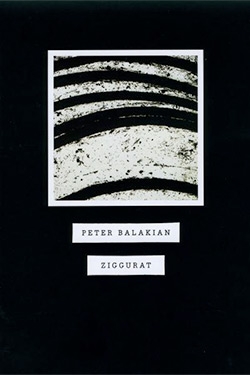Ziggurat
by Peter Balakian
reviewed by Hovig Tchalian
The latest offering from Armenian-American poet Peter Balakian is a collection intriguingly entitled Ziggurat after the pyramids built by the Sumerians in the ancient city of Ur. Coming after a decade-long hiatus, it brings together some of Balakian’s recent work in a collection of new and topical poems exploring the “post-traumatic” decade after 9/11.
Balakian spent the last decade working in other genres and has since become best known for those non-poetic writings—Black Dog of Fate: An American Son Uncovers His Armenian Past (1998), a memoir; and the book-length study, The Burning Tigris: The Armenian Genocide and America’s Response (2004). Like these more explicitly historical books, Ziggurat is also a “retrospective” of sorts, its pages imbued with a visceral sense of the past, both ancient and modern.
Published in September 2010, the collection is ostensibly a reflection on the 9/11 attacks on the World Trade Center. Balakian witnessed the completion of the twin towers some forty years earlier, and a moving poem at the book’s center, A-Train / Ziggurat / Elegy, deftly weaves together the aftermath of the recent attacks with the author’s own experience as a mail runner in the late 1960s and 1970s in and around lower Manhattan.
This poem, and by extension the entire volume, may be considered an extended meditation on the meaning of the towers’ destruction and the ushering in of what Balakian has elsewhere called an age of “anxiety” and “uncertainty.” A-Train / Ziggurat / Elegy traces the historic rise and fall of the Ziggurat of Ur by compressing it into the forty-year arc of the rise and destruction of the twin towers. The poem juxtaposes the ordinary experiences of construction workers and employees in the tower, the speaker’s experiences riding the A-Train, going up and down the elevator, looking out at the Manhattan skyline, with the discovery of the great pyramidal structure. The result is the lyrical equivalent of vertigo, a feeling simultaneously of a great ascent and a sudden fall.
That fall, both literal and metaphorical, acts as the poem’s central structural feature. Ziggurats were built with steps on the outside whose very purpose, the poem suggests, was to act as both pathway and emblem of soaring ambition: “O house of heaven rising / O foundation of earth / O elemental zigzag.” The twin towers, an engineering and architectural marvel in their own day, were likewise built to feature great, glass elevators now embedded within the steel: “twenty-eight grillages supporting the columns of the elevator core of the North Tower, / core box-shaped columns and box beam framing. / Who had ever heard of anything like this?” The poem answers this question elsewhere, suggesting that the elevator—a symbol of hubris as well as a perverse emblem of modernity—had an ancient counterpart in the mythic archetype of the Ziggurat, the tower of Babel.
Ziggurat is deeply retrospective, then, in this sense as well—surveying what got us here, to a modernity rent by cataclysmic events both personal and historical:
You forget that Nebuchadnezzar inherited the region a millennium later.
You forget because it’s just an excavation now,
like my mind when it blanks into itself,
like the horizon when it goes black and the flame
of one oil refinery flickers out at the Syrian border
where once I picked Armenian bones out of the dirt.
Like reels of film hurriedly spliced together, the ambitions of the biblical tyrant Nebuchadnezzar fade into the ancient Ziggurat, the ominous “excavation” of the twin towers, and the rupture of consciousness, the emptying out of the speaker’s “mind when it blanks into itself,” returning finally to the primal act of excavating the bones of Armenian victims of the genocide, strewn across the Syrian desert of Der-el-Zor. The juxtapositions suggest that the antidote to modern self-consciousness is forgetting the past that dislodges history and, thus, ironically dooming its victims to endlessly repeat it.
What makes segments such as these remarkable is their ability to yoke the mythic to the mundane in original and thought-provoking ways. Like the Warhol lithographs that other poems in the collection return to again and again, the series of juxtapositions form a strange palimpsest, an agglomeration of myth, history and personal narrative.
That personal experience is what most closely ties this collection with Peter Balakian’s other works. Whether as a poet, historian, or memoirist, Balakian has consistently cast himself as the modern observer, the consummate “witness,” a New Jersey native of Armenian descent, straddling the line between cultures and ages, translating that experience into words. Ziggurat redefines that act of bearing witness as an act of retrospection in its deepest sense, a looking back that is as much about the experience of fractured consciousness as it is about what it observes.
So while Ziggurat is ostensibly inspired by the events of September 11th, it speaks to a larger experience. If we are to take seriously the proposition that this is a modern “historical” poem, then the volume serves as a partial answer to a difficult question: how do we begin to write such a history in such an age?
Published on March 18, 2013

